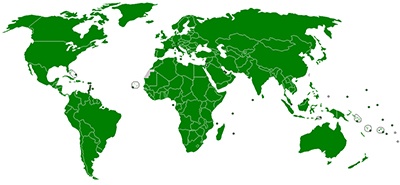 In a previous post we discussed the options consumers and businesses have when it comes to high speed broadband in the UK. In this follow on piece, we’ll take a look at the UK’s position compared to other countries around the world – and future plans in this area.
In a previous post we discussed the options consumers and businesses have when it comes to high speed broadband in the UK. In this follow on piece, we’ll take a look at the UK’s position compared to other countries around the world – and future plans in this area.
Countries around the world see the positive impact that high speed broadband can have on their economies – making companies more productive, enabling services such as telemedicine and e-learning and underpinning innovation. So there is a global drive to increase the rollout of high speed networks
The latest data, covering 2012, from the International Telecommunication Union (ITU) shows that the UK ranks 10th when it comes to fixed broadband penetration, with a score of 34 per 100 people having access. Switzerland tops the table (with 41.9). The UK moved up from 12th place in 2012 and is ahead of countries such as the United States (28), Finland (30.4), Japan (27.9) and Australia (25.1).
But while over a third of Britons having access to broadband is obviously a good thing, there is obviously more to do, both in terms of increasing penetration and ensuring connections are superfast. According to research from Akamai, the average connection speed in the UK is 7.9 Mbps – outside the global top ten, which is led by South Korea (14.2 Mbps), Japan (11.7 Mbps) and Hong Kong (10.9 Mbps). Switzerland is top European nation with an average of 10.1 Mbps.
Around the world fibre is seen as central to increasing speeds and the latest ITU data shows that its deployment is increasing. 22.3% of global connections are now via Fibre to the Cabinet (FTTC)/Fibre to the X (FTTx), although just 2.69% had true superfast Fibre to the Home (FTTH) links. In Europe the leading nation for FTTH is Lithuania, which has 100% coverage and 31% of its homes connected directly to fibre. In comparison the UK has under 0.1% of homes directly fibre connected, mainly due to a high proportion of FTTC deployments.
So, what is the UK doing about this? The government has pledged to deliver superfast broadband to at least 90% of premises within the UK and to provide universal access to standard broadband with a speed of at least 2 Mbps by 2015. On the carrier side BT has set itself a target of providing more than two thirds (66%) of premises with access to fibre broadband by spring 2014.
This obviously leaves a missing 24% of premises, normally in rural areas, that are not in BT’s (or any other carrier’s) plans as they are uneconomic to connect. The Broadband UK (BD UK) programme aims to fill this gap, using local authority and government funds to commission high speed networks on a county by county basis. However, according to a report from the National Audit Office (NAO) the project is running two years behind schedule and won’t meet the 2015 target.
Superfast broadband is becoming central to how we live, work and play. Even in the UK FTTC deployments don’t reach everyone – 10% of people live too far from a cabinet to receive it. So new connection methods are needed, such as microwave links or FTTP via existing telephone poles if everyone in Britain is to benefit from the power of high speed networks in an increasingly competitive global economy. Investment and innovation therefore has to be at the heart of UK broadband in order to accelerate progress in deploying superfast connections across the country. In our third article I’ll outline more on the types of innovation, including some from PPC, that are central to delivering broadband to all.


